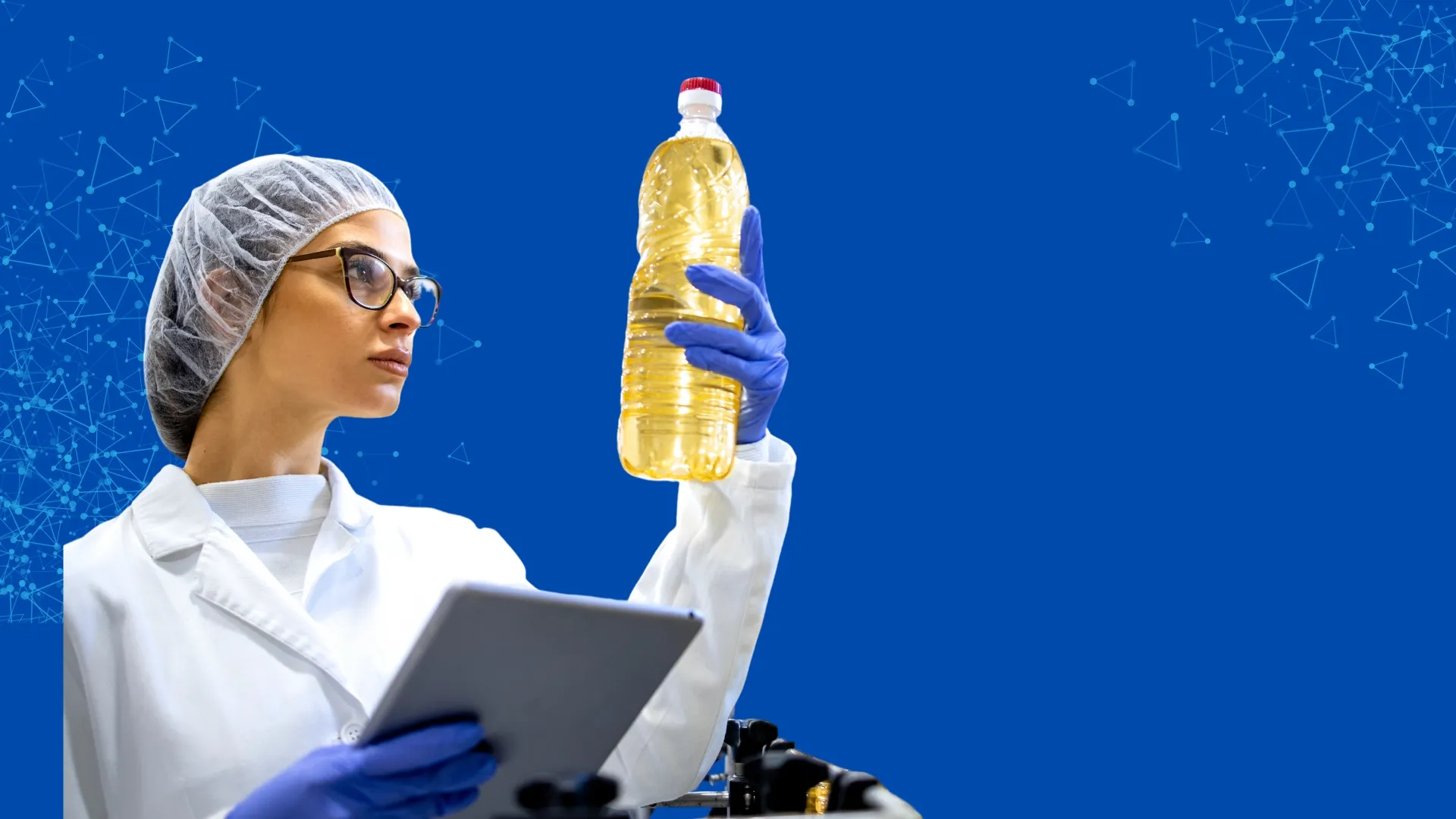Introduction
AI Visual Inspection is transforming the way industries approach quality assurance. In today’s fast-paced, high-volume manufacturing environments, where even the smallest defect can lead to costly recalls or safety risks, traditional manual inspection methods are no longer enough. Manual checks, though useful, are often slow, inconsistent, and prone to human error. By combining computer vision, artificial intelligence, and automated visual inspection systems, businesses can dramatically improve their ability to detect defects, ensure consistency, and optimize production efficiency. This shift to AI-driven quality control empowers organizations to move from reactive inspections to proactive, real-time defect detection, setting a new benchmark for precision and reliability.
This comprehensive guide explores the technologies, applications, challenges, and future trends of AI-driven quality assurance, equipping industry leaders with the insights needed to stay ahead in competitive markets. This guide explores the technologies, strategies, challenges, and future outlook of AI visual inspection showing why it has become an essential component of modern quality assurance.
Transform inspections with AI visual inspection for manufacturing quality assurance
What is AI Visual Inspection?
AI Visual Inspection is the process of using artificial intelligence and computer vision technologies to automatically analyze images or video streams of products during manufacturing. Unlike traditional machine vision inspection systems, AI-powered solutions learn patterns, adapt to variations, and improve accuracy over time.
Where manual or rule-based inspection may miss subtle irregularities, AI defect detection excels at identifying complex defects such as surface scratches, dimensional errors, assembly misalignments, or contamination. This makes AI quality control not just a reactive process but a proactive approach to ensuring consistent product excellence.
Key benefits include:
- •Increased inspection speed and efficiency
- •Reduced dependency on human inspectors
- •Enhanced consistency and repeatability
- •Scalability across multiple production lines
Discover how AI defect detection and visual inspection systems can improve efficiency and compliance
Key Technologies in AI Visual Inspection
The strength of visual inspection AI lies in its integration of several advanced technologies:
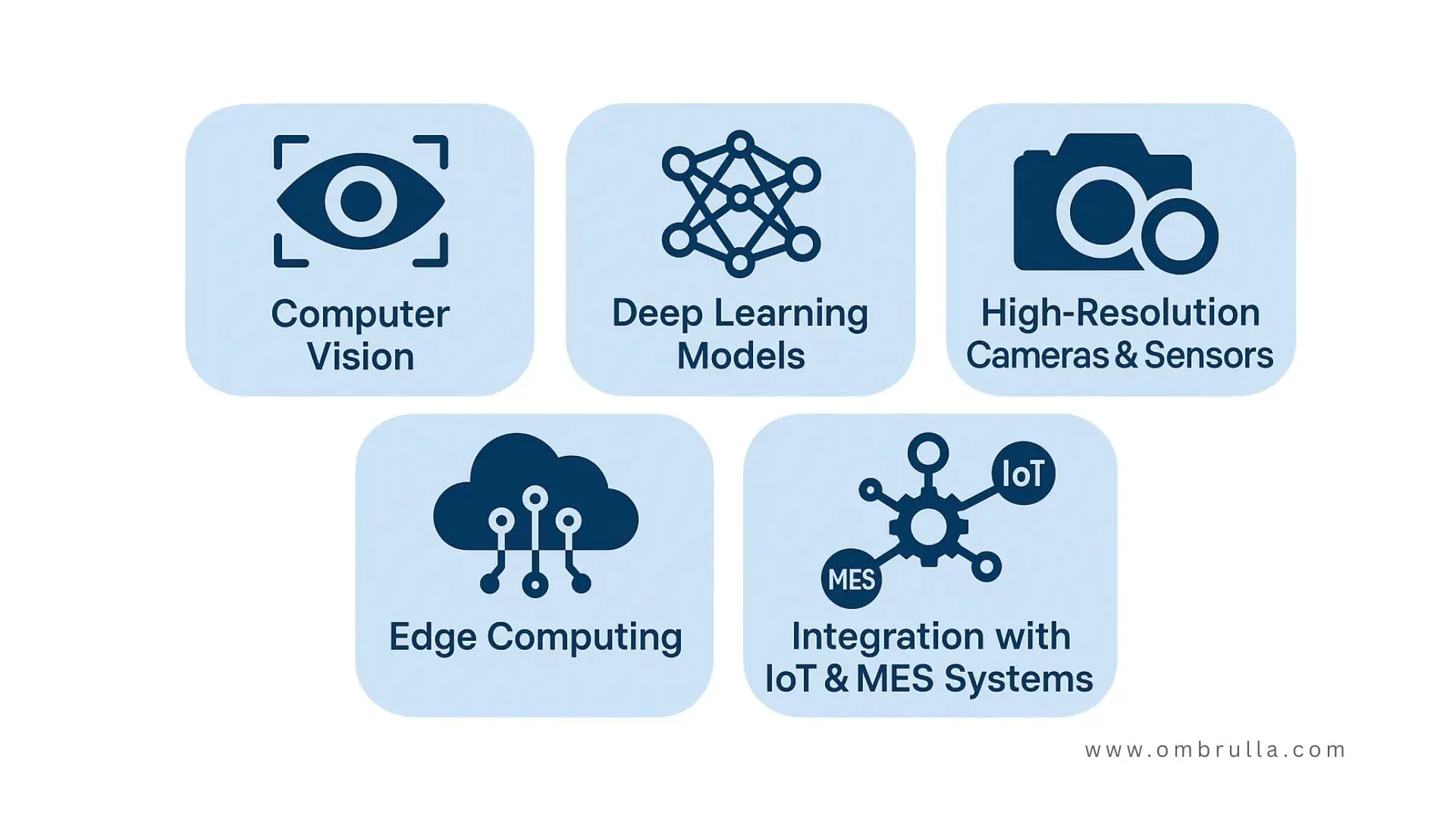
Computer Vision
- •The foundation of automated visual inspection systems. Computer vision algorithms process image data, detect anomalies, and measure attributes.
Deep Learning Models
- •Neural networks power AI defect detection by learning from vast datasets of defective and non-defective samples.
High-Resolution Cameras & Sensors
- •Modern AI inspection systems rely on 2D and 3D imaging, infrared sensors, and hyperspectral cameras to capture even microscopic defects.
Edge Computing
- •Enables real-time inspection on the production line, reducing latency and avoiding costly bottlenecks.
Integration with IoT & MES Systems
- •By connecting AI computer vision with Manufacturing Execution Systems (MES), data-driven insights can flow seamlessly into decision-making processes.
AI Quality Control: A Proactive Approach
Traditional quality control often identifies defects after production, leading to rework or scrap. AI quality control flips this paradigm by identifying potential issues early, enabling corrective actions in real time.
For instance, in the automotive industry, AI can detect welding inconsistencies immediately, preventing defective parts from moving downstream. In pharmaceuticals, automated visual inspection ensures packaging integrity and contamination-free products before they reach consumers.
- •Lower defect rates
- •Reduced waste and material costs
- •Stronger compliance with regulatory standards
- •Improved customer satisfaction
Move from reactive to proactive quality control with real-time AI defect detection in manufacturing
Implementing AI Visual Inspection in Your Business: Key Considerations
While the benefits are compelling, successful implementation requires careful planning.
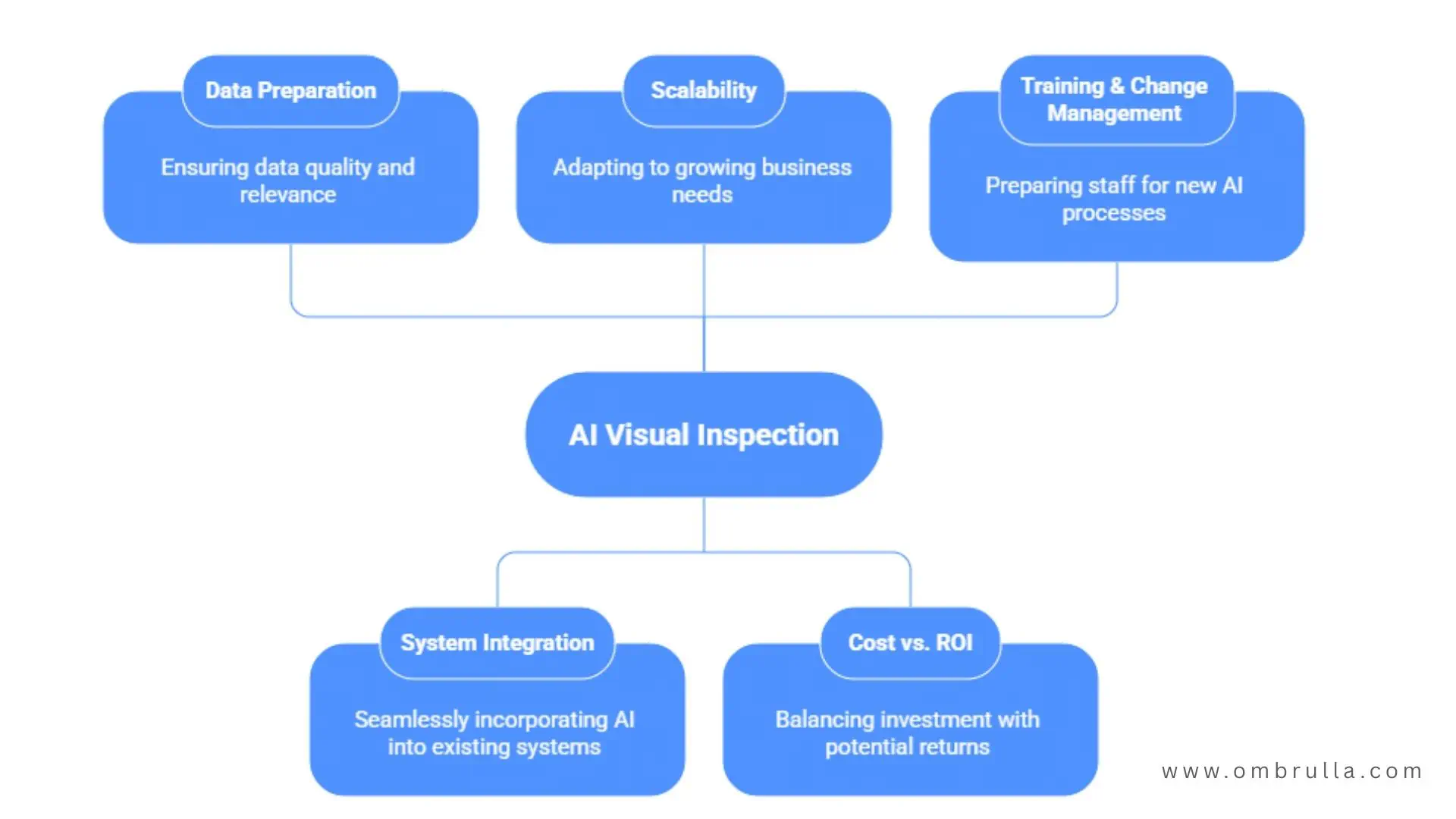
1. Data Preparation
High-quality image datasets are essential. AI systems require thousands of labeled images of both good and defective products.
2. Scalability
Pilot projects should scale across multiple lines or plants, ensuring uniform inspection standards.
3. Training & Change Management
Teams must adapt to new workflows, balancing AI-driven automation with human oversight where necessary.
4. System Integration
An AI inspection system must integrate with existing production equipment, PLCs, and MES platforms.
5. Cost vs. ROI
Although initial investments can be significant, reduced rework, warranty claims, and recalls quickly offset costs.
Plan your transition with scalable AI inspection system integration
The Power of Computer Vision in AI Visual Inspection
The application of computer vision in manufacturing and heavy industries is not simply a step forward, it's a revolution that is transforming how companies approach safety, quality, and efficiency. Unlike traditional rule-based inspection systems that operate within rigid thresholds, AI computer vision can interpret complex patterns, adapt to environmental variability, and learn to recognize even the most subtle anomalies.
Computer vision is not just an incremental upgrade for manufacturing and heavy industries it represents a revolution in safety, quality, and efficiency. Unlike traditional rule-based inspection systems that rely on fixed thresholds, AI-driven vision systems can:
- •Interpret complex visual patterns.
- •Adapt to changing environments.
- •Detect even the most subtle anomalies with high precision.
By going beyond rigid inspection methods, computer vision delivers real-time intelligence and predictive analytics that ensure early detection of issues, minimize risks, and drive continuous improvement. Its adaptability means that the same system can evolve with new data, making it capable of addressing diverse challenges across operations.
With this combination of accuracy, scalability, and flexibility, AI visual inspection empowers organizations to reduce costs, improve compliance, and maintain the highest standards of reliability all with a single, future-ready technology.
Harness the power of AI computer vision for defect detection and predictive analytics
Types of Defects AI Can Detect: The Power of AI Defect Detection
One of the most compelling advantages of AI defect detection is its versatility in identifying multiple defect types simultaneously.
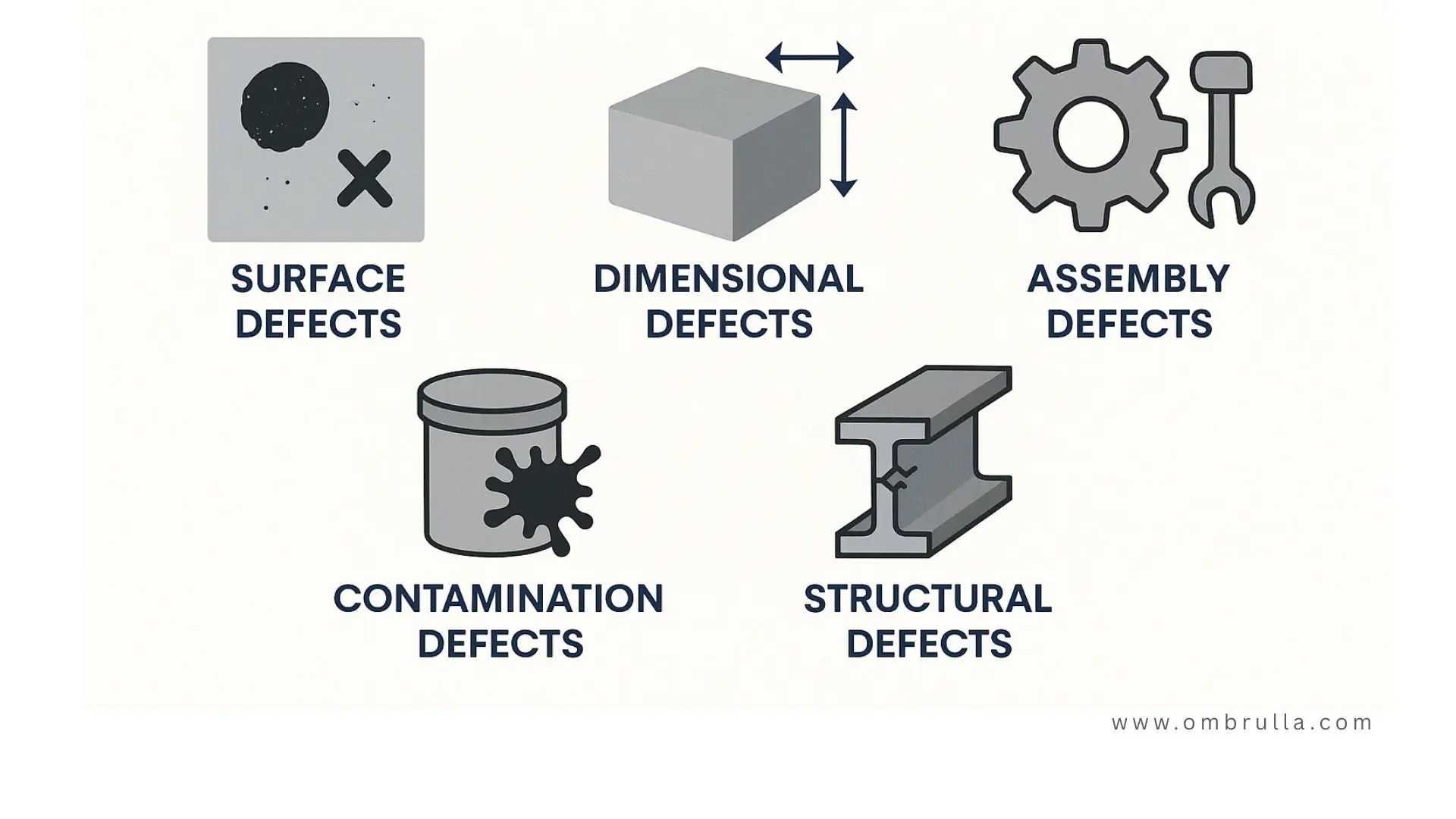
Surface Defects
Surface-level issues such as scratches, dents, corrosion, or discolorations may appear minor, but in high-value applications they can compromise both performance and safety.
- •Oil & Gas: Detecting early-stage corrosion or pitting on pipelines, valves, and offshore structures before they escalate into failures.
- •Automotive: Identifying paint defects, scratches on body panels, or inconsistencies in polished finishes.
- •Manufacturing: Monitoring machining marks, surface roughness, or coating irregularities on metal parts.
With automated visual inspection, these flaws can be flagged in real time, allowing corrective action before products move further down the line.
Dimensional Defects
Even the smallest deviation in size, shape, or alignment can lead to catastrophic outcomes. Using 3D vision, AI inspection systems can measure and verify dimensions at production speed.
- •Automotive: Ensuring gear components, brake systems, and engine blocks meet exact dimensional tolerances.
- •Infrastructure: Verifying alignment in precast concrete beams, steel structures, or rail track assemblies.
- •General Manufacturing: Detecting incorrect thickness in machined parts, sheet metal, or extruded components.
By continuously monitoring dimensions, AI quality control ensures compliance with industry standards and design requirements.
Assembly Defects
Errors during assembly are among the leading causes of recalls and product failures. Visual inspection AI validates that every part is present, aligned, and correctly fastened.
- •Automotive: Checking for missing bolts, loose fasteners, or misaligned components in complex assemblies.
- •Oil & Gas Equipment: Ensuring valves, seals, and connectors are properly installed to prevent leaks.
- •Electronics: Verifying microchips, connectors, and wires are correctly positioned on PCBs.
An AI inspection system can catch these problems instantly, minimizing costly rework and warranty claims.
Contamination Defects
Contamination is a critical defect where safety, reliability, and compliance are at stake. AI defect detection with hyperspectral imaging and advanced sensors can identify contaminants invisible to the human eye.
- •Oil & Gas: Detecting impurities in pipelines or unwanted residues in storage tanks.
- •Pharmaceuticals & Manufacturing: Identifying dust, foreign particles, or oil in sensitive machine components.
- •Infrastructure: Monitoring concrete mixtures for foreign materials that could weaken structural integrity.
Automated visual inspection ensures contamination risks are addressed at the earliest stage, protecting both equipment and end-users.
Structural Defects
Structural issues often arise from material flaws, machine wear, or stress during production. AI computer vision can detect these irregularities before they compromise safety.
- •Automotive: Identifying irregular weld seams or fractures in structural parts.
- •Manufacturing: Detecting uneven coatings, heat-treatment inconsistencies, or internal cracks.
- •Infrastructure: Spotting micro-cracks, spalling, or weak joints in concrete and steel structures.
Early detection of structural defects enables predictive maintenance and prevents costly failures down the line.
Ensure flawless quality with AI defect detection for surface, dimensional, and structural inspections
Ethical Considerations in AI Visual Inspection
As industries increasingly adopt AI visual inspection systems for quality control, it’s important to recognize the ethical implications of these technologies. While AI defect detection delivers clear benefits—improved safety, reduced costs, and enhanced reliability—it also raises challenges that organizations must address responsibly. Below are five key considerations:
1. Workforce Impact and Reskilling
Automated visual inspection reduces reliance on manual inspectors, boosting efficiency and workplace safety by limiting exposure to hazardous environments. To avoid workforce displacement, companies should focus on retraining staff for higher-value roles such as managing AI systems and analyzing inspection data.
2. Bias in Training Data
Poor or unbalanced datasets can cause inaccurate detection. To ensure fairness, AI inspection systems must be trained with diverse, high-quality data and monitored continuously.
3. Transparency & Explainability
In regulated industries, AI inspection systems must clearly explain why a defect was flagged. Explainable models build trust and support compliance.
4. Data Security & Privacy
AI quality control relies on large amounts of production data, raising cybersecurity concerns. Strong governance and data protection are essential.
Challenges and Solutions in Implementing AI Visual Inspection
While AI visual inspection offers game-changing benefits, industries face practical hurdles when integrating these systems into their operations. Understanding these challenges and the solutions available is critical to achieving success with AI defect detection and AI-driven quality control.
Challenge: Data Quality
AI inspection systems require large, diverse, and accurately labeled datasets to function effectively. Poor-quality images, inconsistent labeling, or insufficient defect examples can lead to reduced accuracy, false positives, or missed anomalies.
• Oil & Gas
Detecting corrosion on pipelines or offshore structures requires datasets covering different environments, lighting, and defect stages.
• Automotive
Training data must include multiple surface finishes, colors, and part variations to ensure robust defect detection.
• Manufacturing & Infrastructure
Inconsistent lighting on shop floors or construction sites can degrade image quality, reducing AI accuracy.
Solution:
Companies must invest in comprehensive data collection and annotation pipelines. Leveraging synthetic data augmentation creating simulated defect images helps fill dataset gaps and accelerates training. Regular dataset updates ensure the AI visual inspection system adapts to evolving processes and new product variations.
Challenge: Integration Complexity
Many industries operate with legacy production lines, SCADA systems, and equipment not designed to work with modern AI inspection systems. Integrating AI computer vision into these environments can be technically complex and disruptive.
• Oil & Gas
Remote inspection sites may lack modern infrastructure, making AI deployment challenging.
• Automotive
Complex assembly lines involve multiple inspection points that need seamless integration with AI tools.
• Infrastructure
Construction environments are dynamic, requiring flexible inspection systems that can adapt to changing conditions.
Solution:
The best approach is to use modular and adaptable AI inspection systems that are designed to integrate with existing infrastructure. Cloud-based platforms, edge computing, and open APIs allow AI quality control to be layered onto legacy systems without massive overhauls. This modularity ensures smoother adoption and scalability across multiple facilities.
Challenge: High Initial Investment
Implementing AI-driven quality control often involves high upfront costs—cameras, sensors, edge computing hardware, and training datasets. For smaller manufacturers or infrastructure firms, this can be a barrier.
Large-scale deployment across pipelines, rigs, and refineries can be capital intensive.
• Automotive
Integrating automated visual inspection across multiple production lines requires significant investment.
• General Manufacturing
Smaller suppliers may hesitate due to ROI concerns.
Solution:
Companies should start with pilot projects targeting high-value or high-risk inspection areas. By proving ROI on a smaller scale—such as detecting weld defects in automotive assembly or early-stage corrosion in pipelines—businesses can build confidence and justify larger rollouts. Demonstrating measurable cost savings and defect reduction helps secure stakeholder buy-in for broader deployment.
Challenge: False Positives & Negatives
A common issue in early AI defect detection systems is inaccurate classifications. Too many false positives (flagging good parts as defective) slow down operations, while false negatives (failing to detect real defects) can lead to safety risks, recalls, or structural failures.
• Automotive
False negatives in brake or engine component inspection could compromise safety.
• Oil & Gas
Missed pipeline cracks can cause catastrophic leaks.
Overlooking concrete micro-cracks may lead to premature structural degradation.
Solution:
The key is to continuously train and refine AI defect detection models using feedback loops. Every inspection outcome—whether accurate or flagged for review—feeds back into the system, improving detection accuracy over time. Hybrid approaches, where AI visual inspection handles the majority of defects and humans verify critical cases, provide the balance needed to maintain both speed and reliability.
Overcome adoption barriers with enterprise AI visual inspection deployment strategies
The Future of AI Visual Inspection
The next generation of AI visual inspection is set to move beyond traditional defect detection and transform into a system that is predictive, prescriptive, and self-optimizing. These advancements will not only improve quality but also redefine how organizations approach efficiency, safety, and sustainability.
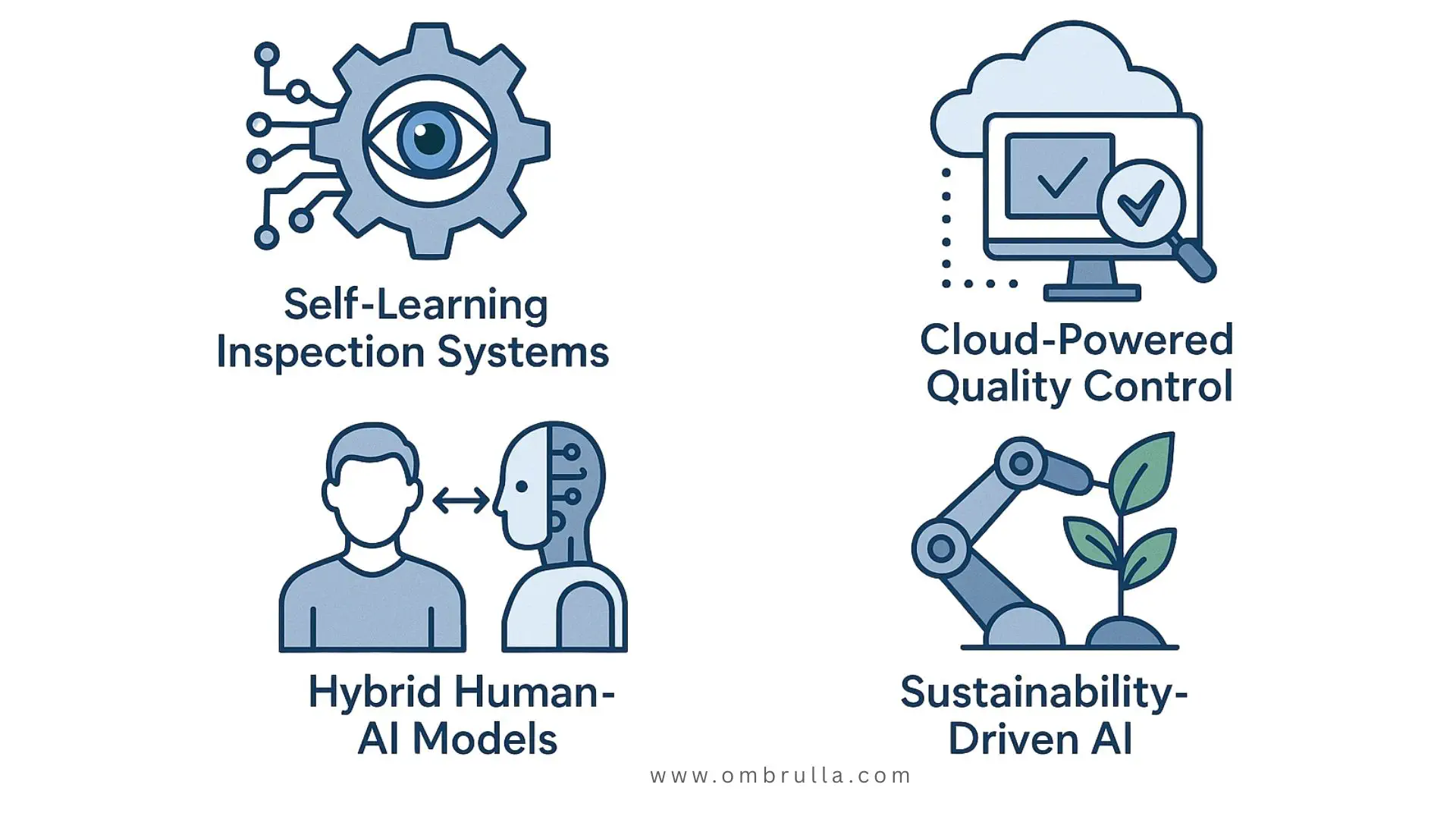
1. Self-Learning Inspection Systems
Future visual inspection AI will be capable of learning continuously on the production floor. Instead of requiring manual retraining, inspection models will autonomously adapt to new defect patterns, product variations, and environmental conditions. This will drastically reduce downtime while ensuring long-term accuracy and reliability.
2. Cloud-Powered Quality Control
As connectivity improves, AI quality control will increasingly be powered by cloud platforms. This will enable real-time data sharing across facilities, standardized quality benchmarks, and global best-practice models that can be deployed instantly across production lines worldwide.
3. Hybrid Human-AI Models
Despite the power of automated visual inspection, human oversight will remain important in high-stakes environments. The future will favor hybrid models, where AI handles the bulk of defect detection at scale, while humans step in for validation of complex or ambiguous cases. This balance ensures both speed and accountability.
4. Sustainability-Driven AI
Sustainability will be a major driver for innovation in AI inspection systems. By catching process deviations early, reducing rework, and minimizing material waste, AI supports environmental sustainability while improving profitability. Energy optimization and predictive maintenance further reduce resource consumption, enabling greener operations and helping companies meet global environmental goals.
By 2030, AI-driven quality assurance will not only ensure flawless products but also redefine how industries approach efficiency, safety, and innovation.
FAQs on AI Visual Inspection
Unlike rule-based systems that remain static, AI visual inspection systems learn continuously. With each new data point and feedback loop, they adapt to new defect types, changing production conditions, and subtle variations that manual or fixed inspections often miss.
Yes. Advanced AI defect detection powered by hyperspectral and 3D imaging can uncover microscopic cracks, material inconsistencies, and contamination invisible under normal lighting conditions making inspections more reliable than ever.
Modern automated systems not only detect defects but also analyze production patterns to predict where and when defects are likely to occur. This proactive approach shifts quality control from defect detection to defect prevention.
Through cloud connectivity, AI visual inspection for global manufacturing quality control enables standardized inspection models to be deployed across multiple sites worldwide. This ensures uniform quality benchmarks, regardless of location, equipment, or workforce skill levels.
By reducing rework, scrap, and wasted resources, AI computer vision lowers material consumption and energy usage. It also enables predictive maintenance, extending equipment lifespan and aligning production with sustainability targets.
Scaling may introduce challenges such as data variability between lines, integration with legacy equipment, and the need for consistent model updates. Modular, flexible solutions are essential to overcome these barriers.
Although initial investment can be significant, companies typically see a strong return on investment (ROI) through reduced defect rates, lower rework costs, fewer warranty claims, and improved operational efficiency. In many cases, payback occurs within 12–24 months.
Through AI visual inspection with mobile, drone, and cobot inspection systems, manufacturers can achieve greater coverage, faster defect detection, and improved safety. These AI-powered inspection tools provide real-time insights, reduce manual errors, and ensure consistent quality control across even the most complex production environments.
Conclusion
AI Visual Inspection has shifted quality assurance from a manual, error-prone task into a scalable, intelligent, and proactive system. By leveraging computer vision, AI defect detection, and automated visual inspection technologies, industries can reduce waste, improve compliance, and deliver products that exceed customer expectations.
As manufacturing becomes increasingly digital and data-driven, adopting AI inspection systems will no longer be optional, it will be a strategic imperative for staying competitive in global markets.
Lead your industry with AI-powered quality control and defect detection systems
